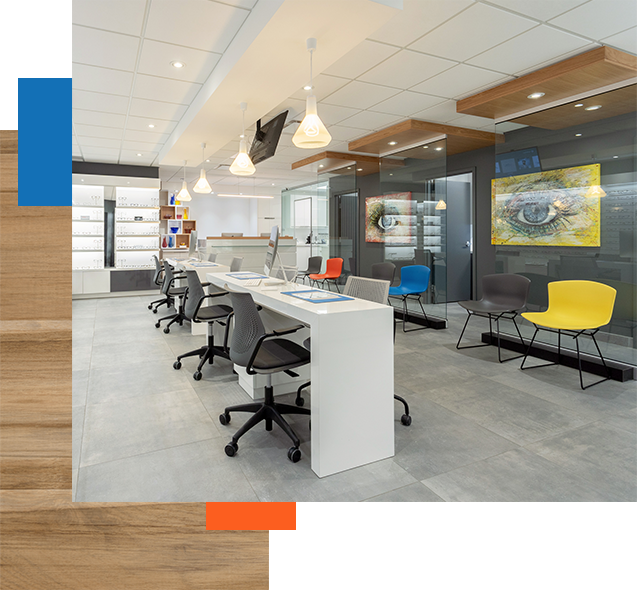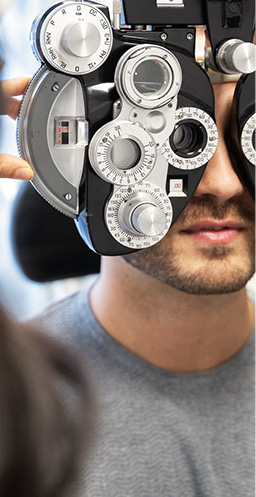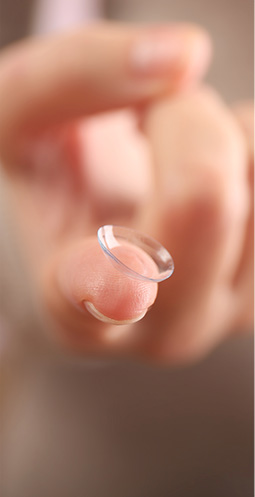Providing Relief for Dry Eye Symptoms
The Canadian National Institute for the Blind estimates that roughly 30% of Canadians suffer from symptoms related to dry eyes. These symptoms are irritating and disruptive, and while you might realize something’s wrong, you may not actually be able to pinpoint that this discomfort comes from dry eyes.
Our trusted and research-backed dry eye treatments include IRPL (intense regulated pulsed light), Jett Plasma Pen, LLLT (low-level light therapy), ZEST eyelid cleansing, and more.
Our conscientious doctors at Stoney Creek Eye Care & Eyewear Boutique, with our progressive approach and highly advanced technology, are well equipped to diagnose and relieve your case of dry eyes. Request an appointment to find relief from your dry eye symptoms.
What are Dry Eyes?
As the name indicates, dry eyes is a chronic condition where the eyes don’t get the moisture they need to keep them clear, protected, and lubricated. Our eyes are lubricated by a thin layer of tears which is called the tear film. This tear film is made up of 3 main components; A mucus layer (closest to the eyes), an aqueous (water layer), and a lipid (oil) layer. Dry eye disease occurs when there is an instability in the tear film, which can lead to ocular surface inflammation and the ocular symptoms of dry eye. Dry eye disease typically stems from one of two basic issues (although there can be an overlap) :
Aqueous Deficient Dry Eye
This is when the lacrimal glands don’t produce enough of the aqueous component of the tear film. The aqueous layer is usually the thickest part of the tear film and when the aqueous volume is low, this can lead to dry eye symptoms. Aqueous deficient dry eye can be further divided into Sjogren Syndrome Dry Eye and Non-Sjogren Dry Eye.
Evaporative Dry Eye
For tears to be really effective, the tear film requires a thin layer of oil that floats on top, preventing the tears from evaporating too quickly. This oil is called meibum and comes from the meibomian glands in the eyelids.
Without enough meibum, the aqueous layer of the tears evaporates, and the eye starts to feel dry and uncomfortable. This condition is what’s called evaporative dry eye.
Symptoms of Dry Eyes
Symptoms of dry eyes can include:
- A dry, gritty sensation
- Periods of excessive tearing
- Blurry or fluctuating vision
- Sensitivity to light
- Stringy discharge
- Redness
- Glare or halos around lights
- Eye fatigue
- Sensation of a foreign body in the eye
Diagnosing Dry Eye
If you’re suffering from dry eye, we can do a complete dry eye workup exam. We’ll discuss your lifestyle and medical history, as factors like computer use and certain medical conditions can increase your risk of dry eye. Then, we’ll use a variety of diagnostic tools to assess what’s causing your dry eyes so we can find the right treatment.
Meibography
Meibography is a diagnostic tool that captures photos of your meibomian glands, the oil glands in your eyelids. We do meibography 2 ways: with the Oculus Keratograph or with an infrared camera mounted to a slit lamp. Both provide detailed photos of your meibomian glands. Using these photos, we can diagnose problems like meibomian gland dysfunction.
Tear Osmolarity
Tear osmolarity is a measure of the salt content of your tears. We use the I-Pen to measure tear osmolarity. It’s a pen-like device that touches your lower inner eyelid for about 2 seconds and then analyzes your tears. High tear film osmolarity or hyperosmolarity can lead to the ocular surface damage associated with dry eyes. Many of the dry eye treatments available are aimed at reducing the tear osmolarity and restoring balance to the tear film
Tear Break Up Time
Tear break up time or TBUT refers to how quickly the tear film starts to evaporate or break up after each blink. We can measure tear break up time in 2 ways: with diagnostic dye on the cornea and a slit lamp or by using the Oculus Keratograph. Patients with dry eyes may have a reduced tear break up time. Dry eye treatments aim to improve the tear break up time and lead to an improvement in dry eye symptoms.
Slit Lamp Biomicroscopy
A slit lamp is a microscope used by your optometrist to look at the structures of the eye in detail. Dry eyes can cause ocular surface inflammation. This can be visualized using a slit lamp and often times diagnostic dye on the cornea which would highlight areas of inflammation caused by dry eyes.
Intense Regulated Pulsed Light
E>Eye is an innovative medical device designed to treat chronic dry eye syndrome using patented intense regulated pulsed light (IRPL) therapy.
This treatment is specifically designed to target the root cause of most chronic dry eye symptoms—meibomian gland dysfunction (MGD)—while also addressing ocular rosacea, another common cause of dry eye. IRPL has been shown to be one of the most effective long-term treatments for dry eye caused by MGD, offering patients relief and improved eye health.
Many years of research and testing have gone into developing the E>Eye.
How Does IRPL Work?
IRPL therapy works by emitting precisely calibrated light pulses that stimulate the meibomian glands located along the edges of the eyelids. These glands are responsible for producing the oils that keep your tears from evaporating too quickly.
The treatment stimulates the parasympathetic nerve that supplies these glands by applying the light to the upper cheek area (just beneath the eyes). This stimulation helps unclog the glands, reduce inflammation, improve gland function, and restore the quality of tears. In addition, IRPL can help prevent further damage to the meibomian glands, potentially restoring their function if they are in the process of atrophying.
The IRPL Process
Your treatment protocol typically involves 4 comfortable, painless sessions. For the best results, we recommend pairing IRPL with the Jett Plasma Pen. In a study, 90% of patients reported reduced symptoms after the first 2 treatments.
In each of your IRPL treatments with us, you’ll wear protective goggles, and we’ll apply ultrasound gel to your upper cheek area. Eight light flashes will be administered to the treatment area. This is then repeated with your other eye.
IRPL + Jett Plasma Pen Treatment Price: 4 total sessions, $1,200
- Your payment may be split and paid at the first and third session
- Sessions 1, 2, & 4 include both treatments, while session 3 is Jett Plasma Pen-only
The IRPL Results
Studies have shown that the effects of IRPL therapy are long-lasting, with relief from dry eye symptoms lasting for a minimum of 6 months and potentially up to 3 years or more. For patients who experience a recurrence of symptoms, single-maintenance treatments can help sustain the results and provide continued relief. E>Eye offers a promising, noninvasive solution to chronic dry eye, and Stoney Creek Eye Care is proud to be one of the few Canadian practices offering this breakthrough treatment.
Dive into the Research Behind IRPL
Eager to learn more? Here are some great resources:
- Study Abstract: Ocular Surface Workup in Patients with Meibomian Gland Dysfunction Treated with Intense Regulated Pulsed Light
- Clinical Trial: Prospective Trial of Intense Pulsed Light for the Treatment of Meibomian Gland Dysfunction
- Research Paper: Intense pulsed light treatment and meibomian gland expression for moderate to advanced meibomian gland dysfunction
The IRPL Benefits
A Purpose-Built Dry Eye Solution: E>Eye addresses meibomian gland dysfunction at the root of the issue. It doesn’t just treat your symptoms, but delivers precise pulses of light to stimulate the glands and restore their natural function. E>Eye was designed specifically to treat dry eye, making it a purpose-built, patient-centered solution.
Improve Your Quality of Life: Treating dry eye can enhance your quality of life by tackling frustrating symptoms that often interfere with daily activities.
After IRPL treatment with us you may notice fast improvements in:
- Vision clarity
- Watery eyes
- Light sensitivity
- Redness
- Irritation & grittiness
Convenient Treatment & Fast Results: The quick, 3-minute sessions make IRPL especially convenient for busy schedules, and the results can often be felt the same day.
Some patients report improvement in gland function within just 2 hours of their first treatment. With continued sessions tailored to your needs, results can last for 6 months to 3 years or more, offering sustainable relief and clearer vision.
Aesthetic Perks: E>Eye IRPL can also provide benefits for skin health and aesthetics. Your IRPL treatment can rejuvenate your skin, soften fine lines and wrinkles, and reduce unwanted pigmentation. It’s also effective for conditions such as rosacea and spider veins, and even for hair removal.
Low-Level Laser Light Therapy (LLLT)
Low-level light therapy (LLLT), also known as photobiomodulation, uses red light wavelengths to activate cell activity and promote healing.
We sell the Arunalight so that you can do your LLLT treatment easily at home. Arunalight uses red and near-infrared light to support eye health by targeting both the eyelids and surrounding tissues. With clinical studies supporting its efficacy, LLLT is widely considered a safe and effective alternative for patients who need an option beyond artificial tears.
By using specific wavelengths of light, LLLT stimulates cellular repair and helps improve the function of the meibomian glands, which are responsible for producing the essential lipid layer of tears.
How Does LLLT Work?
LLLT works by delivering low-level laser light to the affected tissues. The specific wavelength of red light used in this therapy penetrates the skin and reaches deeper layers of tissue, stimulating the cells’ mitochondria to produce more ATP.
ATP is the energy currency of the cell, which helps the cells regenerate and repair themselves. In the case of dry eye and meibomian gland dysfunction, this process improves the health and function of the glands, helping to restore normal tear production and reduce inflammation. The light energy from the laser also helps to reduce pain and discomfort, leading to faster recovery and improved eye comfort.
The LLLT Process
The process for LLLT treatment is simple and comfortable. We generally recommend you use your Arunalight at home 3–4 times per week. It only takes 3 minutes a day, and you can lay back and relax as the therapy works.
The Arunalight is a mask embedded with LEDs that emit red and near-infrared light. With your eyes closed, the light penetrates your eyelids and reaches the meibomian glands. You may feel a faint warming sensation, but the process is entirely noninvasive.
There is no downtime, so you can get back to your day right away. During your appointment, we can advise the optimal schedule for your LLLT treatment based on your symptoms.
The LLLT Results
Studies have shown that LLLT can significantly improve symptoms of dry eye and meibomian gland dysfunction. Patients typically experience reduced inflammation, improved tear production, and relief from discomfort. LLLT has also been shown to enhance the function of the meibomian glands, leading to better tear film quality and reduced dryness.
Research has demonstrated that LLLT can provide lasting relief, with results typically lasting several months. Maintenance treatments may be necessary to maintain the effects over time.
Dive into the Research Behind LLLT
Eager to learn more? Here are some great resources:
- Study: Serial Sessions of a Novel Low-Level Light Therapy Device for Home Treatment of Dry Eye Disease
Study: Thermal Effect on Eyelid and Tear Film After Low-Level Light Therapy and Warm Compress
The LLLT Benefits
Targets Tear Film: LLLT stimulates tear production by enhancing the function of of the lacrimal glands that create your tears.
This increase in tear volume improves your tear film stability, potentially resulting in less grittiness, burning, and irritation, allowing you to experience greater comfort throughout your day.
Fights Chronic Inflammation: Another essential aspect of LLLT is its anti-inflammatory properties. Chronic inflammation often contributes to dry eye syndrome, affecting the surface of your eye. LLLT can reduce this inflammation, promoting healing and restoring balance to the eyes. The therapy helps calm irritated tissues while supporting long-term relief.
Boosts Circulation: Additionally, LLLT can improves blood flow in your eyes by promoting vasodilation, or the widening of blood vessels. The increased circulation delivers essential oxygen and nutrients to the eye tissues while also clearing away metabolic waste products.
Noninvasive & Convenient: LLLT is noninvasive and free of the potential side effects and downtime associated with drugs or surgery. Short treatment times make it easier to fit into your schedule, and it can be paired with other treatments for even better results.
Jett Plasma Pen
The Jett Plasma Pen uses plasma technology to tackle dry eye symptoms caused by MGD, blepharitis, and demodex at their source. Health Canada has already authorized its use for dermatology and aesthetic treatments, and it is increasingly being proven and recognized as an effective option for treating dry eye-related issues.
The Jett Plasma Pen device uses reversible electroporation technology to target and improve the function of crucial components in and around the eyes. By addressing the root causes of dry eye, including inflammation and meibomian gland dysfunction, the Jett Plasma Pen offers both symptom relief and improved tissue health.
How Does Jett Plasma Pen Work?
The Jett Plasma Pen uses pulsed plasma microcurrent (a low electrical current) to effectively treat dry eye caused by MGD and blepharitis. It’s designed to be gentle on the delicate tissues surrounding the eyes.
The treatment uses a noninvasive technique called “reversible electroporation,” which involves creating tiny “pores” in cell membranes using electric charges. This allows micronutrients to flow freely into cells, rejuvenating the tissues.
For dry eye treatment, this means that the device can improve the quality of oil secretions from the eyelids and dissolve hardened oils in the meibomian glands, encouraging them to produce more healthy oils for your tears. Learn more about how it works.
The Jett Plasma Pen can also boost circulation, reducing inflammation in the affected tissues in and around your eyes. Plasma energy helps the oil glands work at their best by breaking down hardened materials like keratin or debris that can clog them. It can also decrease the bacteria on the eyes to improve tear flow and stability.
Additionally, the Jett Plasma Pen stimulates the skin and muscles, encouraging improved blood flow and cellular repair. This has the added benefit of tightening the skin and reducing the appearance of fine lines, making the treatment both functional for dry eye care and rejuvenating.
The Jett Plasma Pen Process
Dry eye therapy with the Jett Plasma Pen is quick and simple. Your treatment protocol will typically involve 4 sessions, and we always recommend pairing the Jett Plasma Pen with IRPL for the best results.
During your session, your doctor uses the pen to apply plasma energy to the areas around the eyes, targeting the eyelids. It takes just a few minutes per eye. Some patients may notice a mild tingling sensation during the procedure.
You can typically return to your daily activities immediately afterward. We’ll let you know your recommended treatment plan in your consultation.
Jett Plasma Pen + IRPL Treatment Price: 4 total sessions, $1,400
The Jett Plasma Pen Results
Patients often notice improvements in their dry eye symptoms shortly after their first session.
The therapy can enhance tear quality by improving the gland function, which is responsible for producing the oily layer of tears, reducing tear evaporation, and reducing dryness. It also combats inflammation and promotes better tear film stability, addressing issues like irritation, redness, and blurry vision.
Over time, with consistent treatment, the benefits can extend to long-lasting relief and healthier gland function, helping patients feel more comfortable on a daily basis.
Dive into the Research Behind Jett Plasma Pen
Eager to learn more? Here are some great resources:
- Ophthalmology Times Europe: A Safe and Effective Non-Ablative Treatment with Multiple Applications for the Ocular Surface
- Study: PMCF Study Final Report
The Post Market Clinical Follow-up “PMCF” study was completed in October last year. The PMCF study was launched on 12.6.2020. It is a prospective, multicentre, randomized, and single-blind controlled post-marketing study. The aim of the study was the treatment of blepharitis/MGD with the JETT PLASMA LIFT MEDICAL silver heads.
The Jett Plasma Pen Benefits
Comfortable: Jett Plasma Pen is noninvasive and comfortable. You can get back to your day immediately after treatment. It’s a great option for people who have not found success with traditional approaches.
Lasting Relief: Many people feel dry eye symptom relief immediately after treatment and feel the benefit for months after. This can mean less-frequent treatment needed.
Safety: This treatment is safe and clinically proven to work for dry eye treatment.
Firmer Skin: Beyond its role in dry eye treatment, the Jett Plasma Pen offers aesthetic perks as well. It stimulates collagen and elastin production, improving skin elasticity and firmness. It’s a noninvasive way to improve skin tone and texture, tighten sagging skin smooth fine lines.
Dry Eye Products
Did you know you can purchase dry eye treatments through our online store?
Meibomian Gland Expression
Meibomian gland expression is a treatment for moderate to severe cases of meibomian gland dysfunction. First, the eye area is gently heated to help loosen clogs and buildup in the meibomian glands.
Then, your optometrist will use forceps to gently squeeze the lids and drain the meibomian glands.
BlephEx
BlephEx cleans and exfoliates the lid margin or the area between the eyelashes and the inside of the eyelid. It is an effective treatment for blepharitis as it helps remove debris that can clog eyelid glands and lead to inflammation.
The treatment device looks like a pen with a sponge tip. The sponge tip spins, gently removing debris and exfoliating the eyelids. Because BlephEx helps to improve tear gland function, many patients find the treatment reduces their dry eye symptoms.
At-Home Treatments
In addition to our in-office treatments, we can help you find the right at-home methods. Based on your symptoms and other treatments you may be receiving, we can recommend eye drops, including gentler, preservative-free varieties.
We also carry treatments like heated eye masks, blepharitis lid hygiene wipes, and specialized omega-3 dry eye supplements to help relieve and treat various dry eye conditions.
Our Vision in Action
At Stoney Creek Eye Care & Eyewear Boutique our trusted team of eye doctors is committed to providing you with high-quality eye care, stylish frames, and personalized attention. We offer a wide variety of services, including:
Convenient Location, Extended Hours,
and Direct Billing
We understand that life is hectic. We want to help make it a little simpler, which is why our centrally-located optometry practice in Stoney Creek offers extended hours on Saturdays. We’re also happy to directly bill most major insurance companies on your behalf. And on top of all that? We’ve got plenty of free parking. Stoney Creek Eye Care & Eyewear Boutique will always do whatever we can to make your life a little easier, located in the Health Science Building.
Our Comprehensive Eye Care Services
At Stoney Creek Eye Care, we’re proud to offer the following eye care services:
- Eye Exams
- Pediatric Eye Exams
- Contact Lens Fittings
- Dry Eye Treatment
- Myopia Control
- Premium Glasses & Sunglasses
- And More!
Serving Stoney Creek and More
We’re proud to be your trusted local optometrist in Stoney Creek and the Greater Hamilton area. We also serve the communities of Cherry Heights, Fruitland, Vincent, Riverdale East, McQuesten West, Normanhurst, Bartonville, Rosedale, Red Hill, and the surrounding areas.
How to Find Us
We’re conveniently located in Stoney Creek, just off King St. E. You can find us on Mountain Ave. S., in the Health Science Building, right next to the Stoney Creek Chamber of Commerce.
Book an appointment with your optometrist in Stoney Creek today!

Stoney Creek Eye Care & Eyewear Boutique
- 15 Mountain Ave S #110
- Stoney Creek, ON L8G 2V6
Contact Information
- Phone: (905) 662-8863
- Email: [email protected]
- Located in the Health Sciences Building
Clinic Hours
- Monday9:00 AM - 6:00 PM
- Tuesday9:00 AM - 6:00 PM
- Wednesday9:00 AM - 6:00 PM
- Thursday9:00 AM - 6:00 PM
- Friday10:00 AM - 5:00 PM
- Saturday8:00 AM - 1:00 PM
- SundayClosed






